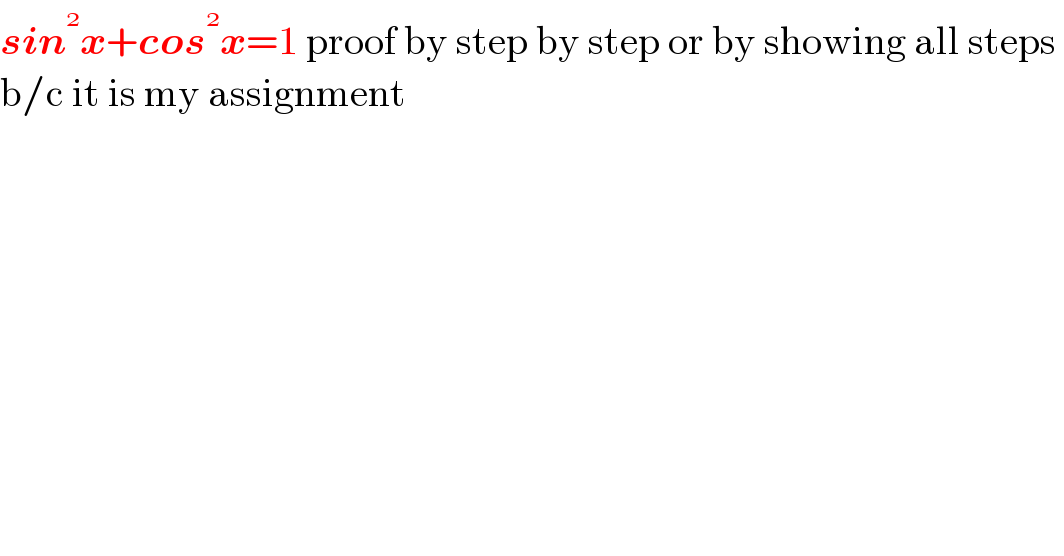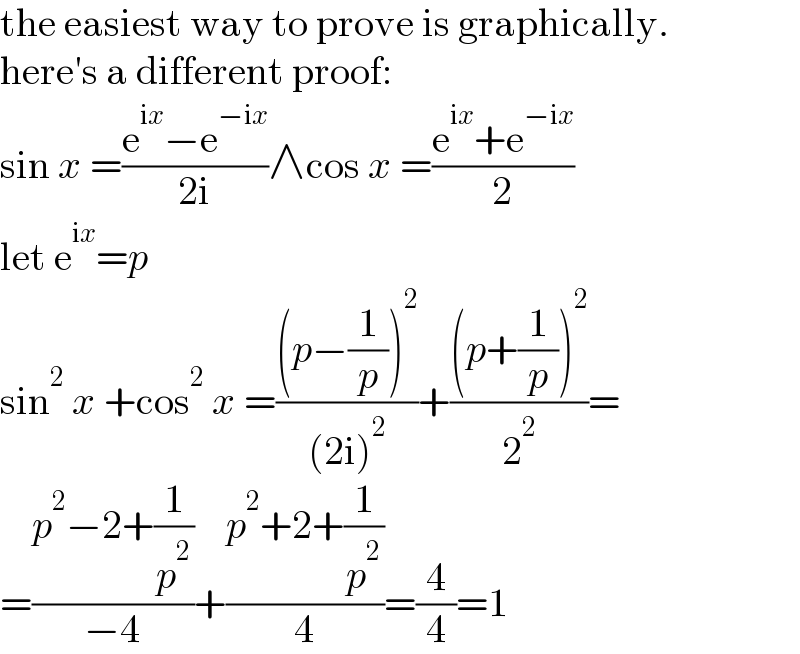
Question Number 129634 by abdurehime last updated on 17/Jan/21

$$\boldsymbol{{sin}}^{ } \boldsymbol{{x}}+\boldsymbol{{cos}}^{ } \boldsymbol{{x}}=\mathrm{1}\:\mathrm{proof}\:\mathrm{by}\:\mathrm{step}\:\mathrm{by}\:\mathrm{step}\:\mathrm{or}\:\mathrm{by}\:\mathrm{showing}\:\mathrm{all}\:\mathrm{steps}\: \\ $$$$\mathrm{b}/\mathrm{c}\:\mathrm{it}\:\mathrm{is}\:\mathrm{my}\:\mathrm{assignment} \\ $$
Answered by MJS_new last updated on 17/Jan/21

$$\mathrm{the}\:\mathrm{easiest}\:\mathrm{way}\:\mathrm{to}\:\mathrm{prove}\:\mathrm{is}\:\mathrm{graphically}. \\ $$$$\mathrm{here}'\mathrm{s}\:\mathrm{a}\:\mathrm{different}\:\mathrm{proof}: \\ $$$$\mathrm{sin}\:{x}\:=\frac{\mathrm{e}^{\mathrm{i}{x}} −\mathrm{e}^{−\mathrm{i}{x}} }{\mathrm{2i}}\wedge\mathrm{cos}\:{x}\:=\frac{\mathrm{e}^{\mathrm{i}{x}} +\mathrm{e}^{−\mathrm{i}{x}} }{\mathrm{2}} \\ $$$$\mathrm{let}\:\mathrm{e}^{\mathrm{i}{x}} ={p} \\ $$$$\mathrm{sin}^{\mathrm{2}} \:{x}\:+\mathrm{cos}^{\mathrm{2}} \:{x}\:=\frac{\left({p}−\frac{\mathrm{1}}{{p}}\right)^{\mathrm{2}} }{\left(\mathrm{2i}\right)^{\mathrm{2}} }+\frac{\left({p}+\frac{\mathrm{1}}{{p}}\right)^{\mathrm{2}} }{\mathrm{2}^{\mathrm{2}} }= \\ $$$$=\frac{{p}^{\mathrm{2}} −\mathrm{2}+\frac{\mathrm{1}}{{p}^{\mathrm{2}} }}{−\mathrm{4}}+\frac{{p}^{\mathrm{2}} +\mathrm{2}+\frac{\mathrm{1}}{{p}^{\mathrm{2}} }}{\mathrm{4}}=\frac{\mathrm{4}}{\mathrm{4}}=\mathrm{1} \\ $$
